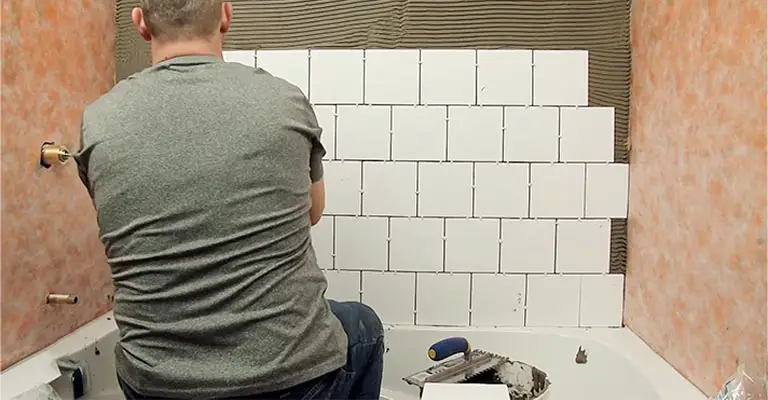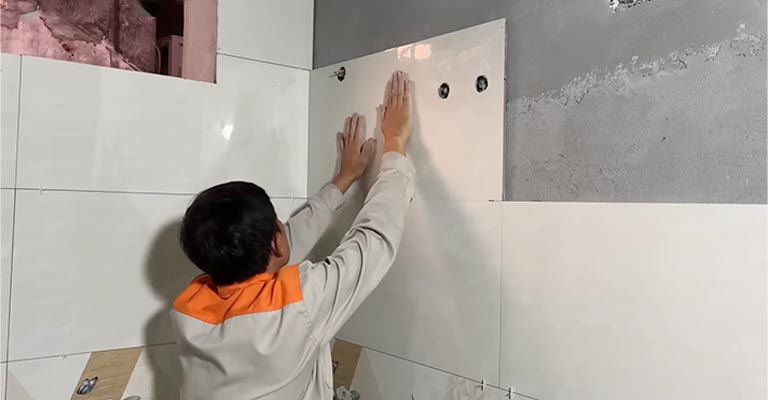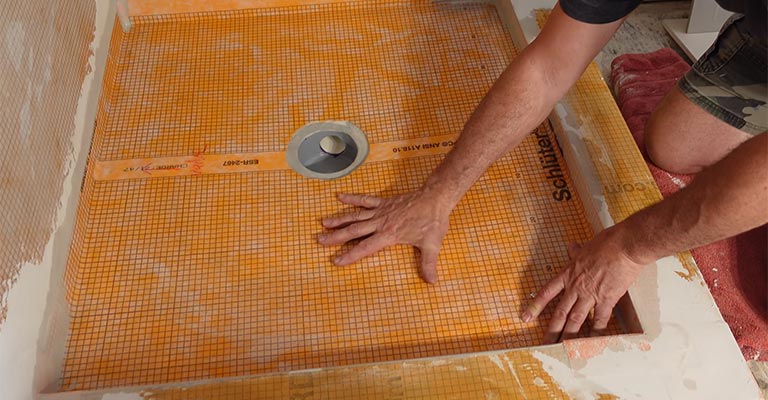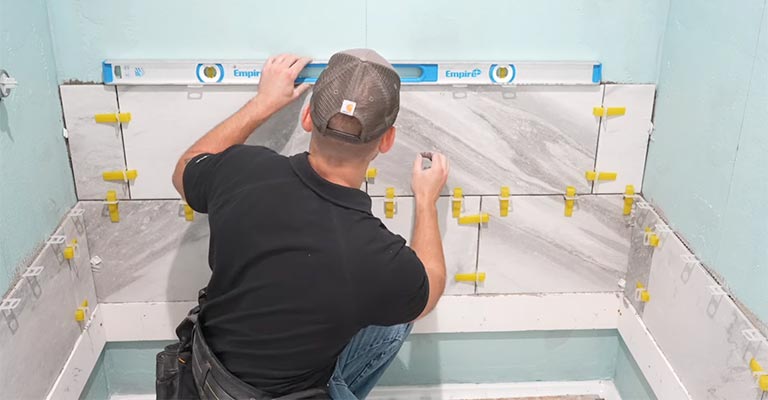Wall tiles are the most popular material used underneath walls, so installing them on drywall may not seem like the best option at first glance.
In areas where the humidity level is low and the surface is secure, you can tile over drywall. Shower walls and other wet areas, such as those in the bathroom, are not recommended for laying tiles.
It is possible for the water in these areas to seep into the tiles, causing damage to them, mold growth, or infestations.
Most of the time, you can cover the drywall with tiles. Tile can be used even over drywall in areas that are subject to some moisture, such as the kitchen or bathroom.
In addition to this being fine, some tile companies even suggest tiling directly on drywall (plasterboard), as it is able to bear more weight than plastered drywall.
You should only take into consideration that if you decide to re-tile in the future, you may have to replace the drywall because removing the old tiles will rip it up.
Is It Safe To Tile Over Drywall?
So long as the wall is prepared before tile installation and the mortar is chosen appropriately, you can put tiles over drywall of areas that don’t have excessive moisture.
Whenever you plan on installing tile within your bathroom area, you’ll need to lay it on the tile backer or cement board designed for wet areas.
The Question Is: How Long Do You Want It To Last?
As compared to tile over backerboard, tile over drywall will not last nearly as long. The builders or flippers who put tile over drywall will be long gone by the time the tile fails in 10-15 years.
If you want your drywall to have the lowest amount of water splashing, you need to install it high enough.
Following that, the HardieBacker cement board will be installed, the seams will be taped and mud (thinset), two or three coats of RedGard waterproofing will be applied, let all that dry, then thinset and tile will be applied.
This method has worked well for me for two showers. Even if the tile was water-resistant, I wouldn’t install it over drywall in a tub or shower.
Any existing drywall and vapor barrier should be removed and replaced with backer board. Thinset and mesh tape should be used to seal the seams.
The seams should be taped with mesh tape and a waterproof membrane such as Red Gard or a similar product. Following the manufacturer’s instructions, apply the waterproofing material to the entire wall surface.
You can install the tile when it is completely dry. If you need a grout that is waterproof and durable, consider epoxy grout. If you need to change the plane, use silicone caulk. This should help a little.
Tile Over Drywall (Showers): A Common but Bad Practice

Throughout the years, we have completed many bathroom remodeling projects in homes that were between 5 and 15 years old. I have encountered the most problems in shower/wet areas when tile is installed over drywall.
I remember this so often that whenever people tell me over the phone that their shower tiles are pushing in with their hands, or that they are falling off the wall or appear ‘squishy’, my mind immediately conjures up images of 4′′ ceramic tiles installed over drywall, which are very common.
Most of the time, that’s what they’ve got.
There is no doubt that this is bad practice, but it is far and away the most common situation I see in the bathrooms we tear out.
Among new home builders and remodelers, this is a common practice because it is so cheap. Besides cost, there are no other benefits.
It is common for these installations to have water damage in the wall, on the studs, wet drywall, mold, mildew, ants, and other water-loving insects within the wall (at least this is what we have found in many cases).
Secondly, there is a persistent black discoloration of the caulking at the bottom of the tiled shower wall (where the base of the shower is attached to the wall).
It doesn’t matter how often you re-caulk this joint, the caulk discolors and turns black again after a few months. Water seeps through grout joints into the drywall, causing it to become damp.
Having daily showers prevents anything from ever drying out because of the constant wetness. I highly recommend you purchase a quality bathroom exhaust fan (please also see the value of having one)
Do I Have The Option Of Tiling Over Drywall?

If you prepare the drywall first and use the correct mortar for the job, you can apply tile to drywall in most rooms without any problems. Most contractors use it because it’s safe and reliable.
It is actually something I have done (or had done) numerous times in two houses my wife and I have renovated and in new constructions.
Only when the drywall is wet or constantly humid should you avoid using tile on it.
The following places in your home should not be tiled over drywall:
- Bathtubs and showers
- Sauna
- It can be anywhere outdoors, such as an outdoor kitchen
It is generally okay to have moisture in some areas. There are, however, potential dangers to be aware of. A common practice among homeowners is to cover their kitchen and bathroom sinks with drywall.
In the event you have plumbing issues or a leak, you may experience some of the issues we’ll cover next, but it’s generally considered safe.
Go With Wedi Board
For tile substrates in showers, we prefer “Wedi Board”. Wedi Board’s core is made up of “blue board” insulation, which provides continuous insulation.
In addition to being 100% waterproof, this closed cell insulation also acts as a “vapor stop” to prevent water vapor from entering the wall cavity.
It is especially important if the shower is located on an outside wall, but it is also important if the shower is located on an inside wall.
The beauty of Wedi Board is that it can be installed in a shower without any tiles (not that you would do this anyway) – and you could take showers without tiling for years (without having any leaks).
Basically, you are providing a beautiful aesthetic to the shower by tiling over the Wedi Board, but you are not relying on the tile to do the waterproofing.
It’s true that the tile adds a layer of waterproofing protection, but the Wedi Board is the real brain of the system.
By using a product that is designed for use in showers, you have an entirely different shower than the common practice of tiling over drywall.
Special bonding agents (known as “wedi caulk” but is much more than caulk) are used in the Wedi Board and Wedi Shower systems to waterproof the seams at corners as well as joints where 3X5 board pieces join together.
Additionally, the pieces are bound together so that the entire shower system functions as one unit behind the tile, helping to prevent cracks in the tile and grout.
Why Can’t You Tile Over Drywall On Wet Areas?

There are no building codes that prohibit tiling over drywall in wet zones, but what makes it dangerous? When it comes to wet spaces, there are three solid reasons not to tile over drywall:
Pests:
A source of water attracts all insects. In the bathroom, moisture accumulates through the tiles, making it a perfect environment for pests like carpenter termites and ants. Other areas of your home can also be damaged by these pests.
Water Damage:
It is possible for moisture to damage drywall as well as the wood behind it. Structural problems may arise if mold is present (and this is likely).
Mold:
Tiles and timber behind it may be soaked with moisture. These damp, dark environments are perfect for mold growth.
Your tiled wall will feel soft when you press on it, and you’ll know when that happens. Suddenly, you’re faced with a serious issue.
There is no doubt that installing tiles over drywall in the bathroom is a bad idea, but the worst part is that tile damage may not be apparent until it is too late. It is important to detect mold or moisture issues if they are present.
Are Large Tiles A Possibility To Install Over Drywall?
That’s right! Tiles would be less likely to cause problems than bricks because their weight per square foot would surpass drywall’s recommendation.
What Mortar Should You Use To Tile Over Drywall?
When installing tile on drywall for backsplashes, thin-set mortar should be used.
The use of a mastic is technically possible, but it is not recommended in areas where there is moisture or humidity, so why take the risk when you can use thin set?
How To Place Tiles In Rooms That Are Humid Or Wet?
As a result, we have developed a strong argument against installing tile directly over damp drywall. The question is: What is the best option for tiling wet areas, such as bathrooms?
Wet Areas Should Be Tiled With Cement Board
Cement board is the best material to use under tiles in wet areas. Similar to drywall, cement board comes in sheets. In the presence of water, it will not grow mold or degrade.
The cement board can be hung the same way as drywall, but there are two key differences:
- To prevent moisture from entering the building, a water barrier is placed between the board and the cement.
- Sealing seams with waterproof tape is a common practice.
- A tile backer that is water-resistant can also be used.
Bottom Line
Wet areas (showers, tub-shower combinations, etc) should never have drywall (and moisture resistant drywall included).
Hardi-Backer or concrete board are preferred methods.
Although when using these products, it is essential to build in the correct vapor barrier, as without it water vapor will be able to make its way through the wall.
As a result of the dew point (on the outside walls) within the wall assembly, this vapor condenses inside the wall (on the inside walls) under certain temperature conditions.
When used correctly, these products will work perfectly. There have been too many installations where Hardibacker and concrete board were used without following manufacturer recommendations.








